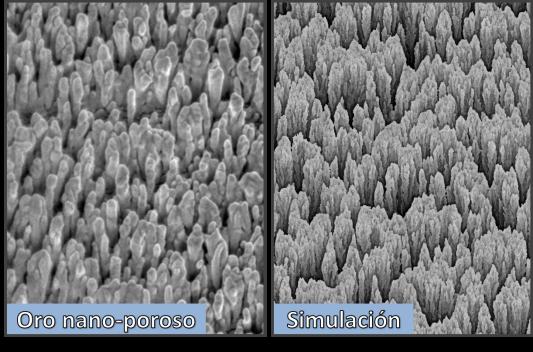Researchers from the Materials Science Institute of Seville, belonging to the Isla de la Cartuja Scientific Research Center (cicCartuja), and the Institute of Microelectronics of Madrid, have succeeded in developing a technique to synthesize nano-porous gold, a key material for the elimination of environmentally harmful gases and to reduce their emission into the atmosphere. Nano-porous gold is a material that contains a large number of cavernous structures of nanometric size, which penetrate deeply from the surface of the material to its interior.
These structures allow the entry of different gases, such as carbon monoxide, sulfur dioxide, ozone, etc., and favor their conversion into other gases that are less harmful to the environment. Although this material had been synthesized previously by chemical methods, the novelty of this new technique lies in the use of plasmas to manufacture it, which allows the porous structures to be arranged and to have greater control over their size, depth of penetration and connectivity. The results of this research have been considered of high interest by the editors of the prestigious journal Nanotechnology*, one of the highest impact in the area of Materials Science, where an article will be published in the near future.
The Spanish team is led by researchers from the Institute of Materials Science of Seville and the Institute of Microelectronics of Madrid, in collaboration with the University of Seville and the HASYLAB center, located in Hamburg (Germany). The mixed nature of the research team, made up of theoretical and experimental scientists, has made it possible to generate knowledge not only from the fundamental point of view, on collective processes of interaction between atoms that give rise to nano-porous structures, but also from the applied point of view, since it has made it possible to synthesize gold with this structure.
To carry out this research, several advanced experimental techniques have been used as well as a multitude of computer simulations that have required months of computation. Two of these simulations can be seen in the videos that appear in the links http://youtu.be/YN23hNeiIVs?hd=1, where the growth of ordered and inclined nano-porous structures can be seen, and in http://youtu.be/i4NSfHg0_lQ?hd=1, where vertical and disordered cavernous structures appear.
The possibility of synthesizing gold with controlled nano-porosity opens a new door to technological applications in fields as diverse as the elimination of polluting gases, sensor development, the petrochemical industry (methanol oxidation), fuel cells, plasmonic materials, etc. This research has been funded by several national and regional research projects, especially by the Consolider Ingenio “FUNCOAT” project, funded by the Ministry of Economy and Competitiveness, and the “PLASMATER” project funded by the Junta de Andalucía.
* Growth regimes of porous gold thin films deposited by magnetron sputtering at oblique incidence: from compact to columnar microstructures”, R. Álvarez, J. M. García-Martín, M. Macías-Montero, L. Gonzalez-Garcia, J.C. González, V. Rico, J. Perlich, J. Cotrino, A. R. González-Elipe, A. Palmero, Nanotechnology, in press.




